ASRock Z77 Extreme6 Review: Legacy Bites Back
by Ian Cutress on July 13, 2012 2:00 PM EST- Posted in
- Motherboards
- ASRock
- Z77
3D Movement Algorithm Test
The algorithms in 3DPM employ both uniform random number generation or normal distribution random number generation, and vary in various amounts of trigonometric operations, conditional statements, generation and rejection, fused operations, etc. The benchmark runs through six algorithms for a specified number of particles and steps, and calculates the speed of each algorithm, then sums them all for a final score. This is an example of a real world situation that a computational scientist may find themselves in, rather than a pure synthetic benchmark. The benchmark is also parallel between particles simulated, and we test the single thread performance as well as the multi-threaded performance.

The Z77 Extreme6 unfortunately comes bottom of our 3DPM test in single threaded mode, almost 2% behind the leader.
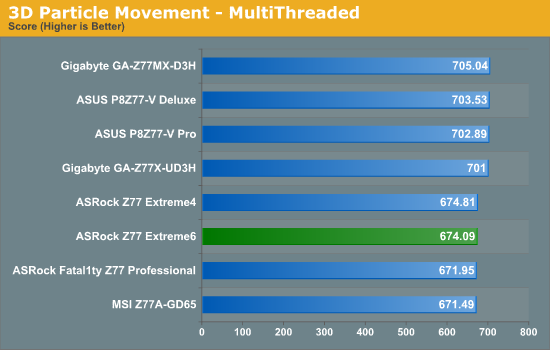
In our multithreaded 3DPM, the ASRock boards, due to their lack of MultiCore Enhancement, feature behind those that do have it. I have a feeling that this 'tweak' will become the norm on future chipsets so no motherboard is left behind on performance.
WinRAR x64 3.93 - link
With 64-bit WinRAR, we compress the set of files used in the USB speed tests. WinRAR x64 3.93 attempts to use multithreading when possible, and provides as a good test for when a system has variable threaded load. If a system has multiple speeds to invoke at different loading, the switching between those speeds will determine how well the system will do.

The ASRock Z77 Extreme6 does well in our WinRAR test, finishing in the middle of the pack - but still behind the ASUS and Gigabyte boards.
FastStone Image Viewer 4.2 - link
FastStone Image Viewer is a free piece of software I have been using for quite a few years now. It allows quick viewing of flat images, as well as resizing, changing color depth, adding simple text or simple filters. It also has a bulk image conversion tool, which we use here. The software currently operates only in single-thread mode, which should change in later versions of the software. For this test, we convert a series of 170 files, of various resolutions, dimensions and types (of a total size of 163MB), all to the .gif format of 640x480 dimensions.
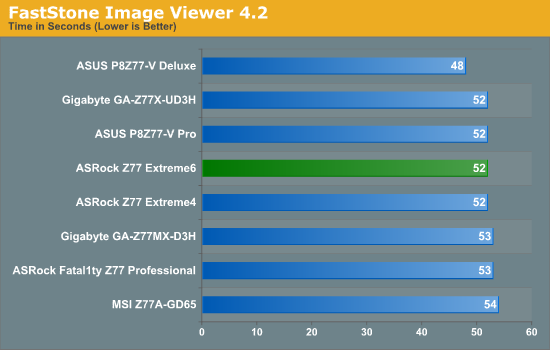
Not a lot to say here, with ASRock being on par with most of the other boards we have tested.
Xilisoft Video Converter
With XVC, users can convert any type of normal video to any compatible format for smartphones, tablets and other devices. By default, it uses all available threads on the system, and in the presence of appropriate graphics cards, can utilize CUDA for NVIDIA GPUs as well as AMD APP for AMD GPUs. For this test, we use a set of 32 HD videos, each lasting 30 seconds, and convert them from 1080p to an iPod H.264 video format using just the CPU. The time taken to convert these videos gives us our result.
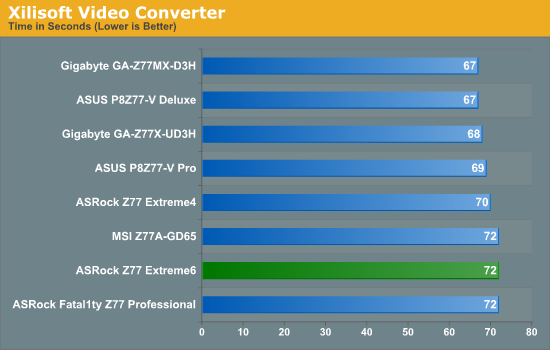
Xilisoft is another test that tells us how well a system responds to variable threaded loading. Unfortunately, in this regard, the Z77 Extreme6 lags behind some 5 seconds off the pace (~7.5%).
x264 HD Benchmark
The x264 HD Benchmark uses a common HD encoding tool to process an HD MPEG2 source at 1280x720 at 3963 Kbps. This test represents a standardized result which can be compared across other reviews, and is dependant on both CPU power and memory speed. The benchmark performs a 2-pass encode, and the results shown are the average of each pass performed four times.
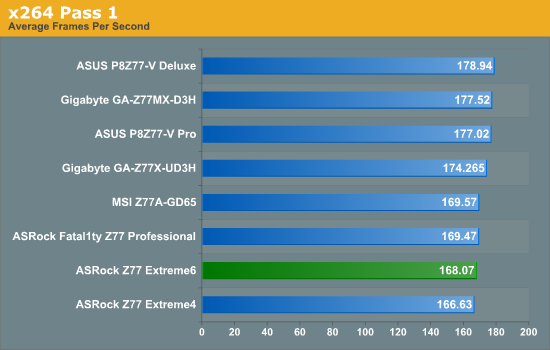
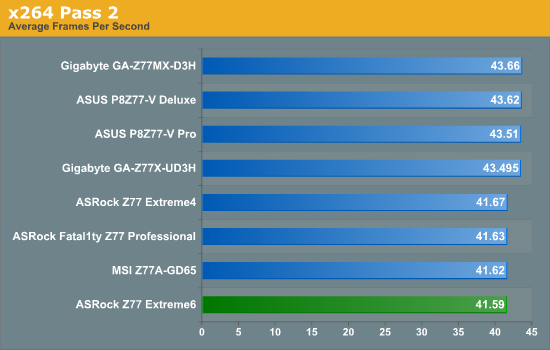
The ASRock Z77 Extreme6 also falls down in our x264 test, as the ASUS and Gigabyte boards have those extra MHz at fully threaded load.










35 Comments
View All Comments
nubie - Saturday, July 14, 2012 - link
Yes, a COM port and Serial port are generally the same thing.I much prefer Parallel, because I am "bit-banging" to program an Atmega micro-controller, a I2C EEPROM, or an SPI EEPROM.
Although I do have a couple Packard Bell Fast Media Infrared (FMIR) receivers that demand a COM port, as does the (sadly lacking drivers newer than Win98) 6-axis Spacetec Orb controller.
Meaker10 - Saturday, July 14, 2012 - link
Without looking at the specs the mini slot is pci-e (for wifi) as it is half height and msata slots need to be full height.repoman27 - Saturday, July 14, 2012 - link
I thought one of the features of the Z77 chipset was that you could select between 1 x16, 2 x8, or 1 x8 + 2 x4 for the PCIe 3.0 lanes coming off of the CPU? In which case you wouldn't need an additional PCIe switch and all three cards would get at least 32 Gbps of PCIe bandwidth...Also, Ian, you seem to have some persistent dyslexia going on when it comes to the model names of PLX's PCIe switches; it's "PEX 8747", not "PXE 8747". There are other options available as well, such as the smaller, cheaper PEX 8724, which would have allowed them to offer effectively 3 x8 PCIe 3.0 slots.
scott967a - Saturday, July 14, 2012 - link
Do you guys ever test wake on lan or other wake up functions? Reason being for the first time I thought I would set up an old sys using Abit P35 Pro for WoL with fail result. Not sure if it is operator error or MB/BIOS problem but searching online doesn't yield much info on WoL performance.529th - Sunday, July 15, 2012 - link
Thank you for including a DPC latency test. Thank you Thank you Thank you! ha...Which app are you using to check DPC latency, btw?
Please include DCP latency testings in your future Motherboard testings as well. I will be jumping on the Haswell wagon when it comes through town.
Cheers
529th - Sunday, July 15, 2012 - link
And also include the BIOS that it's being tested on. Thanks :)IanCutress - Sunday, July 15, 2012 - link
As you can perhaps tell from our DPC Graph, we've been testing it quite a while. And in the explanation of said test, I do mention the program I use - DPC Latency Checker. Quick Google will find it. Currently I'm rarely finding a motherboard on a mainstream chipset that severely fails it - usually it is the included monitoring software that causes peaks of 2000+. If this happens, disable your monitoring software or update the BIOS.Ian
hansmuff - Sunday, July 15, 2012 - link
If I were to release a legacy connector board, I would most certainly at the very least have two serial ports in the back, or one plus header. I would also most certainly include a parallel port header on the motherboard, and include brackets for serial and parallel headers.Floppy and IDE is all good and well, but one serial port and no parallel port are oversights to me for such a board.
adrianlegg - Monday, July 16, 2012 - link
Hello,I just had some random idea,
Couldn't You use, some kind of electric stopwatch, which can be started/paused with any current, connect it to poweron wire (from button), and then instead of using Windows, use some custom linux bootloader with option to, for example, use pc speaker, which signal would be used to stop mobo?
I lack proper knowledge to design that system, aside from components (2 wires, custom bootloader, and stopwatch/some multimeter with time option)
Excuse me if that's completely ignorant, but I think that could increase precision of Your timings.
Thx for all good work.
adrianlegg - Monday, July 16, 2012 - link
(ofc not "stop mobo" but "stop timing")